Toy
This article has multiple issues.Please helpimprove itor discuss these issues on thetalk page.(Learn how and when to remove these messages)
|
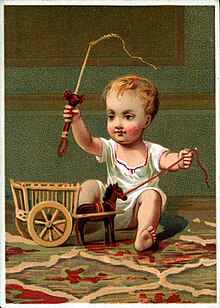
Atoyorplaythingis an object that is used primarily to provideentertainment.Simple examples includetoy blocks,board games,anddolls.Toys are often designed for use by children, although many are designed specifically for adults and pets. Toys can provide utilitarian benefits, including physical exercise, cultural awareness, or academic education. Additionally, utilitarian objects, especially those which are no longer needed for their original purpose, can be used as toys. Examples include children building a fort with empty cereal boxes and tissue paper spools, or a toddler playing with a broken TV remote control. The term "toy" can also be used to refer to utilitarian objects purchased for enjoyment rather than need, or for expensive necessities for which a large fraction of the cost represents its ability to provide enjoyment to the owner, such as luxury cars, high-end motorcycles, gaming computers, and flagship smartphones.
Playing with toys can be an enjoyable way of training young children for life experiences. Different materials like wood, clay, paper, and plastic are used to make toys. Newer forms of toys includeinteractive digital entertainmentandsmart toys.Some toys are produced primarily as collectors' items and are intended for display only.
The origin of toys isprehistoric;dolls representing infants, animals, and soldiers, as well as representations of tools used by adults, are readily found at archaeological sites. The origin of the word "toy" is unknown, but it is believed that it was first used in the 14th century. Toys are mainly made for children.[1]The oldest known doll toy is thought to be 4,000 years old.[2]
Playing with toys is an important part of aging. Younger children use toys to discover their identity, help withcognition,learn cause and effect, explore relationships, become stronger physically, and practice skills needed in adulthood. Adults on occasion use toys to form and strengthen social bonds, teach, help in therapy, and to remember and reinforce lessons from their youth.
Atoymakeris the name of someone who makes toys.
History
Antiquity
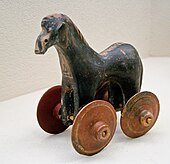
Toys andgameshave been retrieved from the sites of ancient civilizations, and have been mentioned in ancient literature. Toys excavated from theIndus valley civilization(3010–1500 BCE) include small carts, whistles shaped like birds, and toy monkeys that could slide down a string.[3][unreliable source?]One of the earliest examples of children's toys is a set of three stone balls found in the tomb of a four-year-old girl at Xi'anBanpoNeolithic site.[4]
The earliest toys were made from natural materials, such as rocks, sticks, andclay.Thousands of years ago,Egyptianchildren played withdollsthat had wigs and movable limbs, which were made from stone, pottery, and wood.[5]However, evidence of toys in ancient Egypt is exceptionally difficult to identify with certainty in the archaeological record. Small figurines and models found in tombs are usually interpreted as ritual objects; those from settlement sites are more easily labelled as toys. These include spinning tops, balls of spring, and wooden models of animals with movable parts.[6]
Inancient Greeceandancient Rome,children played with dolls made ofwaxorterracotta:sticks,bows and arrows,andyo-yos.When Greek children, especially girls, came of age, it was customary for them to sacrifice the toys of their childhood to thegods.On the eve of their wedding, young girls around fourteen would offer their dolls in a temple as arite of passageinto adulthood.[7][8]
The oldest knownmechanical puzzlealso comes from ancient Greece and appeared in the 3rd century BCE. The game consisted of a square divided into 14 parts, and the aim was to create different shapes from the pieces. InIran,"puzzle-locks" were made as early as the 17th century (CE).[citation needed]
Enlightenment Era
Toys became more widespread with changing Western attitudes towards children and childhood brought about by theEnlightenment.Previously, children had often been thought of as small adults, who were expected to work in order to produce the goods that the family needed to survive. As children's culture scholar Stephen Kline has argued,Medievalchildren were "more fully integrated into the daily flux of making and consuming, of getting along. They had no autonomy, separate statuses, privileges, special rights or forms of social comportment that were entirely their own."[9]
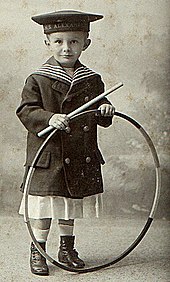
As these ideas began changing during the Enlightenment Era, blowing bubbles from leftover washing up soap became a popular pastime, as shown in the paintingThe Soap Bubble(1739) byJean-Baptiste-Siméon Chardin,and other popular toys includedhoops,toy wagons,kites,spinning wheelsandpuppets.Manyboard gameswere produced byJohn Jefferysin the 1750s, includingA Journey Through Europe.[10]The game was very similar to modern board games; players moved along a track with the throw of adie(ateetotumwas actually used) and landing on different spaces would either help or hinder the player.[11]
In the nineteenth century, Western values prioritized toys with an educational purpose, such as puzzles, books, cards and board games. Religion-themed toys were also popular, including a modelNoah's Arkwith miniature animals and objects from otherBiblescenes. With growing prosperity among themiddle class,children had moreleisuretime on their hands, which led to the application of industrial methods to the manufacture of toys.[11]
More complex mechanical andoptical-based toys were also invented during the nineteenth century.Carpenter and Westleybegan to mass-produce thekaleidoscope,invented by SirDavid Brewsterin 1817, and had sold over 200,000 items within three months in London and Paris. The company was also able to mass-producemagic lanternsfor use inphantasmagoriaand galanty shows, by developing a method ofmass productionusing a copper plate printing process. Popular imagery on the lanterns includedroyalty,floraandfauna,and geographical/man-made structures from around the world.[12]The modernzoetropewas invented in 1833 by British mathematicianWilliam George Hornerand was popularized in the 1860s.[13]Wood andporcelaindollsin miniaturedoll houseswere popular with middle-class girls, while boys played with marbles and toy trains.[citation needed]
Industrial Era and mass-marketed toys

The golden age of toy development occurred during theIndustrial Era.Real wageswere rising steadily in the Western world, allowing even working-class families to afford toys for their children, and industrial techniques of precision engineering and mass production were able to provide the supply to meet this rising demand. Intellectual emphasis was also increasingly being placed on the importance of a wholesome and happy childhood for the future development of children.Franz Kolb,a German pharmacist, inventedplasticinein 1880, and in 1900 commercial production of the material as a children's toy began.Frank Hornbywas a visionary in toy development and manufacture and was responsible for the invention and production of three of the most popular lines of toys based onengineering principlesin the twentieth century:Meccano,Hornby Model RailwaysandDinky Toys.
Meccano was amodelconstruction system that consisted of re-usable metal strips, plates,anglegirders,wheels, axles andgears,withnutsandboltsto connect the pieces and enabled the building of working models and mechanical devices.Dinky Toyspioneered the manufacture ofdie-cast toyswith the production of toy cars, trains and ships and model train sets became popular in the 1920s. TheBritains companyrevolutionized the production oftoy soldierswith the invention of the process ofhollow castingin lead in 1893[14]– the company's products remained the industry standard for many years.
Puzzles became popular as well. In 1893, the English lawyerAngelo John Lewis,writing under the pseudonym of Professor Hoffman, wrote a book calledPuzzles Old and New.[15]It contained, among other things, more than 40 descriptions of puzzles with secret opening mechanisms. This book grew into a reference work for puzzle games and was very popular at the time. TheTangrampuzzle, originally from China, spread to Europe and America in the 19th century.
In 1903, a year after publishingThe Tale of Peter Rabbit,English authorBeatrix Pottercreated the firstPeter Rabbitsoft toyand registered him at thePatent Officein London, making Peter the oldest licensed character.[16]It was followed by other "spin-off" merchandise over the years, including painting books and board games. TheSmithsonianmagazine stated, "Potter was also an entrepreneur and a pioneer in licensing and merchandising literary characters. Potter built a retail empire out of her" bunny book "that is worth $500 million today. In the process, she created a system that continues to benefit all licensed characters, fromMickey MousetoHarry Potter."[17]
In tandem with the development of mass-produced toys, Enlightenment ideals about children's rights to education and leisure time came to fruition. During the late 18th and early 19th century, many families needed to send their children to work in factories and other sites to make ends meet—just as their predecessors had required their labor producing household goods in the medieval era.[18]Business owners' exploitation and abuse of child laborers during this period differed from how children had been treated as workers within a family unit, though. Thanks to advocacy including photographic documentation of children's exploitation and abuse by business owners, Western nations enacted a series of child labor laws, putting an end to child labor in nations such as the U.S. (1949).[19]This fully entrenched, through law, the Western idea that childhood is a time forleisure,not work—and with leisure time comes more space for consumer goods such as toys.[20]
During theSecond World War,some new types of toys were created through accidental innovation. After trying to create a replacement forsynthetic rubber,the AmericanEarl L. Warrickinadvertently invented "nutty putty" duringWorld War II.Later, Peter Hodgson recognized the potential as a childhood plaything and packaged it asSilly Putty.Similarly,Play-Dohwas originally created as a wallpaper cleaner.[21]In 1943Richard Jameswas experimenting with springs as part of his military research when he saw one come loose and fall to the floor. He was intrigued by the way it flopped around on the floor. He spent two years fine-tuning the design to find the best gauge of steel and coil; the result was theSlinky,which went on to sell in stores throughout the United States.[citation needed]
After theSecond World War,as society became ever more affluent and new technology and materials (plastics) for toy manufacture became available, toys became cheap and ubiquitous in households across the Western World. At this point,name-brandtoys became widespread in the U.S.–a new phenomenon that helped market mass-produce toys to audiences of children growing up with ample leisure time and during a period of relative prosperity.[20]
Among the more well-known products of the 1950s there was the Danish companyLego's line of colourful interlocking plastic brick construction sets (based onHilary Page'sKiddicraftSelf-Locking Bricks, described by London'sV&A Museum of Childhoodas among the "must-have toys" of the 1940s[22]),Mr. Potato Head,theBarbie doll(inspired by theBild Lilli dollfrom Germany), andAction Man.[23]TheRubik's Cubebecame an enormous seller in the 1980s. In modern times, there are computerized dolls that can recognize and identify objects, the voice of their owner, and choose among hundreds of pre-programmed phrases with which to respond.[24]
Culture
The act of children's play with toys embodies the values set forth by the adults of their specific community, but through the lens of the child's perspective. Within cultural societies, toys are a medium to enhance a child's cognitive, social, and linguistic learning.[25]
In some cultures, toys are used as a way to enhance a child's skillset within the traditional boundaries of their future roles in the community. InSaharanandNorth Africancultures, play is facilitated by children through the use of toys to enact scenes recognizable in their community such as hunting and herding. The value is placed in a realistic version of development in preparing a child for the future they are likely to grow up into. This allows the child to imagine and create a personal interpretation of how they view the adult world.[26]
However, in other cultures, toys are used to expand the development of a child's cognition in an idealistic fashion. In these communities, adults place the value of play with toys to be on the aspirations they set forth for their child. In the Western culture, the Barbie and Action-Man represent lifelike figures but in an imaginative state out of reach from the society of these children and adults. These toys give way to a unique world in which children's play is isolated and independent of the social constraints placed on society leaving the children free to delve into the imaginary and idealized version of what their development in life could be.[26]
In addition, children from differing communities may treat their toys in different ways based on their cultural practices. Children in more affluent communities may tend to be possessive of their toys, while children from poorer communities may be more willing to share and interact more with other children. The importance the child places on possession is dictated by the values in place within the community that the children observe on a daily basis.[27]
Child development
This sectionneeds additional citations forverification.(May 2022) |
Toys, like play itself, serve multiple purposes in both humans and animals. They provide entertainment while fulfilling an educational role. Toys enhancecognitive behaviorand stimulate creativity. They aid in the development of physical and mental skills which are necessary in later life.
Woodenblocks,though simple, are regarded by early childhood education experts such as Sally Cartwright (1974) as an excellent toy for young children; she praised the fact that they are relatively easy to engage with, can be used in repeatable and predictable ways, and are versatile and open-ended, allowing for a wide variety of developmentally appropriate play.[28]Andrew Witkin, director of marketing forMega Brands,toldInvestor's Business Dailythat "They help develop hand-eye coordination, math and science skills and also let kids be creative."[29]Other toys likemarbles,jackstones,andballsserve similar functions in child development, allowing children to use their minds and bodies to learn aboutspatial relationships,cause and effect,and a wide range of other skills.

One example of the dramatic ways that toys can influence child development involves clay sculpting toys such asPlay-DohandSilly Puttyand their home-made counterparts. Mary Ucci, Educational Director of the Child Study Center ofWellesley College,has demonstrated how such toys positively impact thephysical development,cognitive development,emotional development,andsocial developmentof children.[30]
Toys for infants often make use of distinctive sounds, bright colors, and uniquetextures.Through repetition of play with toys, infants begin to recognize shapes and colors.Play-Doh,Silly Puttyand other hands-on materials allow the child to make toys of their own.
Educational toysfor school age children of often contain apuzzle,problem-solving technique, or mathematical proposition. Often toys designed for older audiences, such as teenagers or adults, demonstrate advanced concepts.Newton's cradle,a desk toy designed bySimon Prebble,demonstrates theconservation of momentum and energy.
Not all toys are appropriate for all ages of children.[31]Even some toys which are marketed for a specific age range can even harm the development of children in that range, such as when for example toys meant for young girls contribute to the ongoing problem of girls' sexualization in Western culture.[32]
A study suggested that supplying fewer toys in the environment allows toddlers to better focus to explore and play more creatively. The provision of four rather than sixteen toys is thus suggested to promote children's development and healthy play.[33]
Age compression
Age compression is the modern trend of children moving through play stages faster than was the case in the past. Children have a desire to progress to more complex toys at a faster pace, girls in particular. Barbie dolls, for example, were once marketed to girls around 8 years old but have been found to be more popular in recent years with girls around 3 years old,[34]with most girls outgrowing the brand by about age 7.[35]The packaging for the dolls labels them appropriate for ages 3 and up. Boys, in contrast, apparently enjoy toys and games over a longer timespan, gravitating towards toys that meet their interest in assembling and disassembling mechanical toys, and toys that "move fast and things that fight". An industry executive points out that girls have entered the "tween"phase by the time they are 8 years old and want non-traditional toys, whereas boys have been maintaining an interest in traditional toys until they are 12 years old, meaning the traditional toy industry holds onto their boy customers for 50% longer than their girl customers.[34]
Girls gravitate towards "music, clothes, make-up, television talent shows and celebrities". As young children are more exposed to and drawn to music intended for older children and teens, companies are having to rethink how they develop and market their products.[36]Girls also demonstrate a longer loyalty to characters in toys and games marketed towards them.[37]A variety of global toy companies have marketed themselves to this aspect of girls' development, for example, theHello Kittybrand and theDisney Princessfranchise.[38]Boys have shown an interest in computer games at an ever-younger age in recent years.[citation needed]
Gender
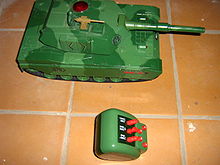
Certain toys, such asBarbiedolls and toy soldiers, are often perceived as being more acceptable for one gender than the other. The turning point for the addition of gender to toys came about in the 1960s and 1970s. Before 1975, only about two percent of toys were labeled by gender, whereas today on the Disney store's website, considered a dominating global force for toys by researcher Claire Miller, all toys are labeled by gender.[39]The journalSex Rolesbegan publishing research on this topic in 1975, focusing on the effects of gender in youth. Too, many psychological textbooks began to address this new issue. Along with these publications, researchers also started to challenge the ideas of male and female as being opposites, even going as far as to claim toys which have characteristics of both genders are preferable.[40]
A milestone for research on gender is the use ofmeta-analysis,which provides a way to assess patterns in a systematic way, especially relevant for a topic such as gender, which can be difficult to quantify.[40]Nature and nurturehave historically been analyzed when looking at gender in play, as well as reinforcement by peers and parents of typicalgender rolesand consequently, gender play.[40]Toy companies have often promoted the segregation by gender in toys because it enables them to customize the same toy for each gender, which ultimately doubles their revenue. For example, Legos added more colors to certain sets of toys in the 1990s, including colors commonly attributed to girls such as lavender.[citation needed]
It has been noted by researchers that, "Children as young as 18 months display sex-stereotyped toy choices".[41]When eye movement is tracked in young infants, infant girls show a visual preference for a doll over a toy truck (d > 1.0). Boys showed no preference for the truck over the doll. However, they did fixate on the truck more than the girls (d =.78).[42]This small study suggests that even before any self-awareness of gender identity has emerged, children already prefer sex-typical toys. These differences in toy choice are well established within the child by the age of three.[43]
Another study done by Jeffrey Trawick-Smith took 60 different children ages three to four and observed them playing with nine different toys deemed best for development. They were allowed to play with the toys in a typical environment, a preschool classroom, which allowed for the results to be more authentic compared to research done in a lab. The researchers then quantified play quality of the children with each toy based on factors such as learning, problem solving, curiosity, creativity, imagination, and peer interaction. The results revealed that boys generally received higher scores for overall play quality than girls, and the toys with the best play quality were those identified as the most gender neutral, such as building blocks and bricks along with pieces modeling people. Trawick-Smith then concluded that the study encourages a focus on toys which are beneficial to both genders in order to create a better balance.[44]
While some parents promote gender neutral play, many parents encourage their children to participate in sex-typed activities, including doll-playing and engaging in housekeeping activities for girls and playing with trucks and engaging in sports activities for boys.[45]Researcher Susan Witt said that parents are the primary influencer on the gender roles of their children.[46]Parents, siblings, peers, and even teachers have been shown to react more positively to children engaging in sex-typical behavior and playing with sex-typical toys.[47]This is often done through encouragement or discouragement, as well as suggestions[46]and imitation.[citation needed]Additionally, sons are more likely to be reinforced for sex-typical play and discouraged from atypical play.[47]However, it is generally not as looked down upon for girls to play with toys designed "for boys", an activity which has also become more common in recent years.[48]Fathers are also more likely to reinforce typical play and discourage atypical play than mothers are.[49]A study done by researcher Susan Witt suggests that stereotypes are oftentimes only strengthened by the environment, which perpetuates them to linger in older life.[46]
This stereotypical attribution of sex-typical toys for girls and boys is gradually changing, with toys companies creating more gender neutral toys, as the benefits associated with allowing children to play with toys that appeal to them far outweighs controlling their individual preferences.[50]For example, many stores are beginning to change their gender labels on children's play items.Targetremoved all identification related to gender from their toy aisles and Disney did the same for their costumes.[39]The Disney store is an especially prevalent example of gender in play because they are a global identity in the toy world. A study done regarding their website found that though they have removed gender labels from their costumes, the toys online reflect more stereotypical gender identities. For example, toys depicting males were associated with physicality and females were associated with beauty, housing, and caring.[51]Though Disney promotes their toys as being for both genders, there is no gender neutral section on their website. Those which are generally deemed for both genders more closely resemble what many would label "boy toys," as they relate closer to the stereotype of masculinity within play.[51]
Traditions within various cultures promote the passing down of certain toys to their children based on the child's gender. InIndigenous South Americancommunities, boys receive a toy bow and arrow from their father while young girls receive a toy basket from their mother.[25]In North African and Saharan cultural communities, gender plays a role in the creation of self-made dolls. While female dolls are used to represent brides, mothers, and wives, male dolls are used to represent horsemen and warriors. This contrast stems from the various roles of men and women within the Saharan and North African communities. There are differences in the toys that are intended for girls and boys within various cultures, which is reflective of the differing roles of men and women within a specific cultural community.[26]
Research on the repercussions of gender in toys suggests that desegregation of the genders can be achieved by encouraging more gender-neutral play.[44]Researchers Carol Auster and Claire Mansbach have argued that allowing children to play with toys which more closely fit their talents would help them to better develop their skills.[51]In terms of parental influence, a study found that parents who demonstrated some androgynous behavior have higher scores in support, warmth, and self-worth in regards to the treatment of their children.[46]Even as this debate is evolving and children are becoming more inclined to cross barriers in terms of gender with their toys, girls are typically more encouraged to do so than boys because of the societal value of masculinity.[39]
Economics
This sectionneeds additional citations forverification.(May 2022) |
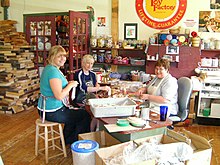
With toys comprising such a large and important part of human existence, the toy industry has a substantial economic impact. Sales of toys often increase around holidays where gift-giving is a tradition. Some of these holidays include Christmas, Easter,Saint Nicholas Day,andThree Kings Day.
In 2005, toy sales in the United States totaled about $22.9 billion.[29]Money spent on children between the ages of 8 and twelve alone totals approximately $221 million annually in the U.S.[52]It was estimated that in 2011, 88% of toy sales was in the age group 0–11 years.[53]

Toy companies change and adapt their toys to meet the changing demands of children thereby gaining a larger share of the substantial market. In recent years many toys have become more complicated with flashing lights and sounds in an effort to appeal to children raised around television and the internet. According toMattel's president, Neil Friedman, "Innovation is key in the toy industry and to succeed one must create a 'wow' moment for kids by designing toys that have fun, innovative features and include new technologies and engaging content."
In an effort to reduce costs, many mass-producers of toys locate their factories in areas where wages are lower. China manufactures about 70 percent of the world's toys and is home to more than 8,000 toy firms, most of which are located in thePearl River DeltaofGuangdong Province.[54]75% of all toys sold in the U.S., for example, are manufactured in China.[29]Issues and events such as power outages, supply of raw materials, supply of labor, and raising wages that impact areas where factories are located often have an enormous impact on the toy industry in importing countries.
Many traditional toy makers have been losing sales tovideo gamemakersfor years. Because of this, some traditional toy makers have entered the field ofelectronic gamesand have even been turningaudio gamesinto toys, and are enhancing the brands that they have by introducing interactive extensions or internet connectivity to their current toys.[55]
In addition, the rise ofdistributed manufacturingenables consumers to make their own toys fromopen sourcedesigns with a3-D printer.[56]As of 2017 consumers were already offsetting millions of dollars per year by3D printingtheir own toys fromMyMiniFactory,a single repository.[57][58]
Types

This sectionneeds additional citations forverification.(May 2022) |
Construction sets
The Greek philosopherPlatowrote that the futurearchitectshould play at building houses as a child.[59]Aconstruction setis a collection of separate pieces that can be joined to createmodels.Popular models include cars,spaceships,and houses. The things that are built are sometimes used as toys once completed, but generally speaking, the object is to build things of one's own design, and old models often are broken up with the pieces reused in new models.
The oldest and perhaps most common construction toy is a set of simple woodenblocks,which are often painted in bright colors and given to babies and toddlers. Construction sets such asLegobricks andLincoln Logsare designed for slightly older children and have been quite popular in the last century. Construction sets appeal to children (and adults) who like to work with their hands, puzzle solvers, and imaginative sorts.
Some other examples includeBayko,Konstruk-Tubes,K'Nex,Erector Sets,Tinkertoys,andMeccano,and generic construction toys such asNeodymium magnet toys.
Dolls and miniatures

Adollis a model of a human (often a baby), a humanoid (likeBert and Ernie), or an animal. Modern dolls are often made of cloth or plastic. Other materials that are, or have been, used in the manufacture of dolls includecornhusks,bone,stone,wood,porcelain(sometimes called china),bisque,celluloid,wax,and even apples. Often, people will make dolls out of whatever materials are available to them.
Sometimes intended as decorations, keepsakes, orcollectiblesfor older children and adults, most dolls are intended as toys for children, usually girls, to play with. Dolls have been found inEgyptiantombs that date to as early as 2000 BCE.[5]
Dolls are usually miniatures, but baby dolls may be of true size and weight. A doll orstuffed animalof soft material is sometimes called aplush toyorplushie.A popular toy of this type is theTeddy Bear.

A distinction is often made between dolls andaction figures,which are generally of plastic or semi-metallic construction and poseable to some extent, and often are merchandising from television shows or films which feature the characters. Modern action figures, such asAction Man,are often marketed towards boys, whereas dolls are often marketed towards girls.
Toy soldiers,perhaps a precursor to modernaction figures,have been a popular toy for centuries. They allow children to act out battles, often with toy military equipment and a castle or fort. Miniature animal figures are also widespread, with children perhaps acting out farm activities with animals and equipment centered on a toy farm.
Vehicles

Children have played with miniature versions of vehicles since ancient times, with toy two-wheeledcartsbeing depicted onancient Greek vases.[59]Wind-up toyshave also played a part in the advancement of toy vehicles. Modern equivalents include toycarssuch as those produced byMatchboxorHot Wheels,miniature aircraft, toy boats,military vehicles,andtrains.Examples of the latter range from wooden sets for younger children such asBRIOto more complicated realistictrain modelslike those produced byLionel,DoepkeandHornby.Larger die-cast vehicles, 1:18 scale, have become popular toys; these vehicles are produced with a great attention to detail.[citation needed]
Puzzles

A puzzle is aproblemor Enigma that challenges ingenuity. Solutions to puzzles may require recognizingpatternsand creating a particular order. People with a highinductive reasoning aptitudemay be better at solving these puzzles than others. Puzzles based on the process of inquiry and discovery to complete may be solved faster by those with gooddeductionskills. A popular puzzle toy is theRubik's Cube,invented by HungarianErnő Rubikin 1974. Popularized in the 1980s, solving the cube requires planning and problem-solving skills and involves algorithms.
There are many different types of puzzles; for example, amazeis a type oftour puzzle.Other categories include:construction puzzles,stick puzzles,tiling puzzles,disentanglement puzzles,sliding puzzles,logic puzzles,picture puzzles,lock puzzles,andmechanical puzzles.
Collectibles
Some toys, such asBeanie Babies,attract large numbers of enthusiasts, eventually becomingcollectibles.Other toys, such asBoyds Bearsare marketed to adults as collectibles. Some people spend large sums of money in an effort to acquire larger and more complete collections. The record for a singlePez dispenserat an auction, for example, is US$1100.[60]
Promotional merchandise

Many successful films, television programs, books and sport teams have official merchandise, which often includes related toys. Some notable examples areStar Wars(a space fantasy franchise) andArsenal,an Englishfootballclub.
Likewise, many successful children's films, television series, books or franchises extend their marketing campaign tofast foodchains by including small toys of fictional characters or the series' associated symbols in a sealed plastic bag within theirkids' meals.One famous example is theHappy MealfromMcDonald's.[61]
Promotional toys can fall into any of the other toy categories; for example, they can be dolls or action figures based on the characters of movies or professional athletes, or they can be balls, yo-yos, orlunch boxeswith logos on them. Sometimes they are given away for free as a form of advertising.Model aircraftare often toys that are used by airlines to promote their brand, just astoy cars and trucksandmodel trainsare used by trucking, railroad and other companies as well. Many food manufacturers run promotions where a toy is included with the main product as aprize.Toys are also used aspremiums,where consumers redeemproofs of purchasefrom a product and pay shipping and handling fees to get the toy. Some people go to great lengths to collect these sorts of promotional toys.
Digital toys
Digital toys are toys that incorporate some form of interactive digital technology.[62]Examples of digital toys includevirtual petsandhandheld electronic games.Among the earliest digital toys areMattel Auto Raceand theLittle Professor,both released in 1976. The concept of using technology in a way that bridges the digital with the physical world, providing unique interactive experiences for the user, has also been referred to asphygital.[63]
Physical activity

A large amount of toys are part of active play. These include traditional toys such ashoops,tops,jump ropes,andballs,as well as more modern toys likeFrisbees,foot bags,fidget toys,astrojax,andMyachi.
Playing with these sorts of toys allows children to exercise, building strong bones and muscles and aiding inphysical fitness.Throwing and catching balls and Frisbees can improvehand–eye coordination.Jumping rope, (also known as skipping) and playing with foot bags can improve balance.
Safety regulations

Many countries have passedsafety standardslimiting the types of toys that can be sold. Most of these seek to limit potential hazards, such aschokingorfire hazardsthat could cause injury. Children, especially very young ones, often put toys into their mouths, so the materials used to make a toy are regulated to prevent poisoning. Materials are also regulated to prevent fire hazards. Young children cannot judge what is safe and what is dangerous, and parents do not always think of all possible situations, so such warnings and regulations are important on toys.[citation needed]
Every country has its own regulations on toy safety, but since theglobalizationand opening of markets, most of them try to harmonize their regulations. The most common danger for younger children is to put toys in their mouths. This is why chemicals contained in paint and other components of children's products are carefully regulated. Countries or trade zones such as theEuropean Unionregularly publish lists to regulate the quantities or ban chemicals from toys and juvenile products. The globalization of toys has had negative effects on locally produced toys in various countries, pushing out traditional ways of play[64]and presenting new risks to children in areas where parentalliteracylevels make it hard for parents to understand the risks and age-appropriateness of various imported toys.[64]
There have also been issues of toy safety regardinglead paint.Some toy factories, when projects become too large for them to handle, outsource production to other less known factories, often in other countries. Recently,[when?]there were some in China that America had to send back. The subcontractors may not be watched as closely and sometimes use improper manufacturing methods. The U.S. government, along with mass market stores, is now moving towards requiring companies to submit their products to testing before they end up on shelves.[65]
Disposal
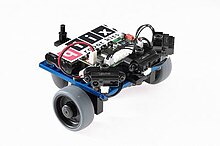
This articlecontainsinstructions, advice, or how-to content.(May 2022) |
When toys have been outgrown or are no longer wanted, they may be donated to charity, sold atgarage sales,auctioned,or even donated to museums. However, when toys are broken, worn out or otherwise unfit for use, care should be taken when disposing of them. Donated or resold toys should be gently used, clean and have all parts.[66]Before disposal of any battery-operated toy, batteries are removed and recycled; some communities demand this be done. Some manufacturers, such asLittle Tikes,will take back and recycle their products.
In 2007, massiverecalls of toys produced in China[67]led many U.S.-based charities to cut back on, or even discontinue, their acceptance of used toys. Goodwill stopped accepting donations of any toys except for stuffed animals, and other charities checked all toys against government-issued checklists.[68]
TheWEEE directive (Waste Electrical and Electronic Equipment),which aims at increasing re-using, reducing, and recyclingelectronic waste,applies to toys in the United Kingdom as of 2 January 2007.[69]
Toy use in animals
It is not unusual for some animals to play with toys. An example of this is a dolphin being trained to nudge a ball through a hoop. Young chimpanzees use sticks as dolls–the social aspect is seen by the fact that young females more often use a stick this way than young male chimpanzees.[70][71]They carry their chosen stick and put it in their nest. Such behaviour is also seen in some adult female chimpanzees, but never after they have become mothers.
See also
- Antique toy show
- Boys' games and toys
- Battery recycling
- Board games
- Card games
- Girls' games and toys
- List of toys
- List of toys and children's media awards
- List of wooden toys
- National Toy Hall of Fame(United States)
- Toy museums
- Toy Story,a franchise about anthropomorphic toys
- Traditional Mexican handcrafted toys
References
- ^"toy – Origin and meaning of toy by Online Etymology Dictionary".etymonline.
- ^"FYI: What Is the Oldest Toy in the World?".Popular Science.18 March 2019.
- ^"MrDonn.org Free Lesson Plans & Activities for K-12 teachers & students".Archived from the original on 19 September 2008.
{{cite web}}:CS1 maint: unfit URL (link) - ^Guo, Li; Eyman, Douglas; Sun, Hongmei (2024). "Introduction". In Guo, Li; Eyman, Douglas; Sun, Hongmei (eds.).Games & Play in Chinese & Sinophone Cultures.Seattle, WA:University of Washington Press.p. 6.ISBN9780295752402.
- ^abMaspero, Gaston Camille Charles.Manual of Egyptian Archaeology and Guide to the Study of Antiquities in Egypt.Project Gutenberg.
- ^Wilkinson, Toby (2008).Dictionary of Ancient Egypt.Thames & Hudson. p.251.ISBN978-0-500-20396-5.
- ^Powell, Barry B. (2001).Classical Myth; Third Edition.Upper Saddle River, NJ: Prentice Hall. pp.33–34.ISBN978-0-13-088442-8.
- ^Oliver, Valerie (1996)."History of the Yo-Yo".Spintastics Skill Toys, Inc. Archived fromthe originalon 9 August 2006.Retrieved30 October2006.
- ^Klein, Stephen(1998). Jenkins, Henry (ed.).The Children's Culture Reader.New York University Press. pp. 95–109.
- ^FRB Whitehouse (Table Games of Georgian and Victorian Days, Priory House, Herfortshire, UK, 1951)
- ^ab"History of Toys".everydaytoys.Archived fromthe originalon 20 December 2013.Retrieved17 December2012.
- ^Shedding some light on the magic lanternArchived21 December 2013 at theWayback Machine.Mervyn Heard. Retrieved 1 August 2011.
- ^Bordwell, David and Kristin Thompson,Film History: An Introduction,3rd ed. (New York: McGraw-Hill, 2010), 4.ISBN978-0-07-338613-3
- ^Joplin, N. (1996).Toy Soldiers.London: Quintet Publishing, Ltd.
- ^"Puzzles Old and Newby Professor Hoffmann ".puzzlemuseum.
- ^"Peter Rabbit blazed a trail still well trod".The Times.Retrieved6 October2022.
- ^"How Beatrix Potter Invented Character Merchandising".Smithsonian.Retrieved6 October2022.
- ^Reed, Lawrence W."Child Labor and the British Industrial Revolution".Mackinac Center for Public Policy.Retrieved10 April2022.
- ^"National Child Labor Committee".Library of Congress.Retrieved10 April2022.
- ^abHains, Rebecca C.; Jennings, Nancy A. (2021).The Marketing of Children's Toys.Palgrave. p. 2.
- ^"On the invention of silly putty, from Lemelson-MIT Program".web.mit.edu.Archived fromthe originalon 16 February 2003.
- ^"Must Have Toys 1940s – V&A Museum of Childhood".V&A Museum of Childhood.Victoria and Albert Museum, London.Retrieved11 October2018.
- ^"A Brief History of Toys".localhistories.org.Retrieved17 December2012.
- ^Van Patten, Denise."A Brief History of Talking Dolls – From Bebe Phonographe to Amazing Amanda".About. Archived fromthe originalon 12 May 2013.Retrieved30 October2006.
- ^abSmith, Peter K (2010).Children and Play:Understanding Children's Worlds.West Sussex, UK: John Wiley & Sons. pp. 89–94.ISBN978-0-631-23521-7.Retrieved5 December2016.
- ^abcRossie, Jean-Pierre (2005).Toys, Play, Culture, and Society. An anthrological approach with reference to North Africa and the Sahara.Stockholm: SITREC. pp. 88–91.ISBN978-91-974811-3-7.Retrieved5 December2016.
- ^Starr, Benjamin (13 March 2013)."Toy Stories: Children's Favorite Toys Around the World".Visual News. Archived fromthe originalon 6 January 2017.Retrieved5 December2016.
- ^Cartwright, Sally (March 1974). "Blocks and learning".Young Children.29(3): 141–146.JSTOR42657609.
- ^abcTsuruoka, Doug (5 January 2007)."Toys: Not All Fun And Games".Investor's Business Daily.Archived fromthe originalon 9 October 2009.Retrieved8 January2007.
- ^Ucci, Mary (April 2006)."Playdough: 50 Years' Old, And Still Gooey, Fun, And Educational".Child Health Alert.24.Retrieved17 February2007.[permanent dead link](Note that the full-text online version requires login.)
- ^Bernard, Susan (1994).The Mommy Guide: Real-life Advice and Tips from Over 250 Moms and Other Experts.Contemporary Books.ISBN978-0-8092-3797-5.
- ^"Report of the APA Task Force on the Sexualization of Girls".American Psychological Association.Retrieved10 April2022.
- ^Dauch, Carly; Imwalle, Michelle; Ocasio, Brooke; Metz, Alexia E. (February 2018)."The influence of the number of toys in the environment on toddlers' play".Infant Behavior and Development.50:78–87.doi:10.1016/j.infbeh.2017.11.005.PMID29190457.
- ^abPressler, Margaret Webb (29 October 2011)."Bored with her toys".The Washington Post.Retrieved2 April2006.
- ^Hains, Rebecca (1 February 2016)."A Barbie with curves is still all about looks".The Washington Post.Retrieved10 April2022.
- ^"Kid Rhino Addresses Age Compression By Tweaking Products, Strategies".Billboard.10 March 2001.Retrieved15 February2018– via Google Books.
- ^Tansel, Utku (19 October 2010)."Effects of age compression on traditional toys and games".Euromonitor International. Archived fromthe originalon 5 April 2012.Retrieved29 October2011.
- ^Hains, Rebecca (2014).The Princess Problem.Sourcebooks.ISBN978-1402294037.
- ^abcMiller, Claire Cain (30 October 2015)."Boys and Girls, Constrained by Toys and Costumes".The New York Times.
- ^abcZosuls, Kristina M.; Miller, Cindy Faith; Ruble, Diane N.; Martin, Carol Lynn; Fabes, Richard A. (June 2011)."Gender Development Research in Sex Roles: Historical Trends and Future Directions".Sex Roles.64(11–12): 826–842.doi:10.1007/s11199-010-9902-3.PMC3131694.PMID21747580.
- ^Caldera, Yvonne M.; Huston, Aletha C.; O'Brien, Marion (February 1989). "Social Interactions and Play Patterns of Parents and Toddlers with Feminine, Masculine, and Neutral Toys".Child Development.60(1): 70–76.doi:10.2307/1131072.JSTOR1131072.PMID2702876.
- ^Alexander, G. M.; Wilcox, T.; Woods, R. (2009). "Sex differences in infants' visual interest in toys".Archives of Sexual Behavior.38(3): 427–433.doi:10.1007/s10508-008-9430-1.PMID19016318.S2CID20435292.
- ^Alexander, G. M.; Saenz, J. (2012). "Early androgens, activity levels and toy choices of children in the second year of life".Hormones and Behavior.62(4): 500–504.doi:10.1016/j.yhbeh.2012.08.008.PMID22955184.S2CID25564513.
- ^abTrawick-Smith, Jeffrey; Wolff, Jennifer; Koschel, Marley; Vallarelli, Jamie (July 2015). "Effects of Toys on the Play Quality of Preschool Children: Influence of Gender, Ethnicity, and Socioeconomic Status".Early Childhood Education Journal.43(4): 249–256.doi:10.1007/s10643-014-0644-7.S2CID145171764.
- ^Eccles, Jacquelynne S.; Jacobs, Janis E.; Harold, Rena D. (July 1990). "Gender Role Stereotypes, Expectancy Effects, and Parents' Socialization of Gender Differences".Journal of Social Issues.46(2): 183–201.doi:10.1111/j.1540-4560.1990.tb01929.x.
- ^abcdWitt, Susan D (1997). "Parental influence on children's socialization to gender roles".Adolescence.32(126): 253–259.PMID9179321.ProQuest195928943.
- ^abServin, A.; Bohlin, G.; Berlin, L. (1999). "Sex differences in 1-, 3-, and 5-year olds' toy-choice in a structured play-session".Scandinavian Journal of Psychology.40(1): 43–48.doi:10.1111/1467-9450.00096.PMID10216463.
- ^"Toys for Girls and Boys".Canadian Toy Testing Council.Archived fromthe originalon 4 March 2000.
- ^Berenbaum, S. A., Martin, C. L., Hanish, L. D., Briggs, P. T., & Fabes, R. A. (2008). Sex differences in children's play. In J. Becker, K. Berkley, N. Geary, E. Hampson, J.Herman, & Young, E.A. (Eds.), Sex Differences in the Brain from Genes to Behavior (1ed., pp. 275–290).New York, NY: Oxford University Press.
- ^"Gender Neutral Toys: How They Empower Our Kids".Toy Review Experts.22 June 2017.[permanent dead link]
- ^abcAuster, Carol J.; Mansbach, Claire S. (1 October 2012). "The Gender Marketing of Toys: An Analysis of Color and Type of Toy on the Disney Store Website".Sex Roles.67(7): 375–388.doi:10.1007/s11199-012-0177-8.S2CID143551702.
- ^"Parents of tweens seek balance for fast-maturing kids".CNN. Associated Press. 28 November 2006. Archived fromthe originalon 1 December 2006.Retrieved16 March2008.
- ^Crupnick, Russ."Drilling to the Core in Toy Spending".npdgroupblog.NPD Group. Archived fromthe originalon 12 March 2013.Retrieved12 February2013.
- ^Chen, Dezhi; Wei, William; Hu, Daiping; Muralidharan, Etayankara (5 September 2016). "Survival strategy of OEM companies: a case study of the Chinese toy industry".International Journal of Operations & Production Management.36(9): 1065–1088.doi:10.1108/IJOPM-04-2015-0212.
- ^"World in their hands".The Age.Melbourne. 26 March 2007.
- ^"Researchers run the numbers on cutting the cost of toys by 3-D printing them at home".Geekwire.20 July 2017.
- ^Petersen; et al. (2017)."Impact of DIY Home Manufacturing with 3-D Printing on the Toy and Game Market".Technologies.5(3): 45.doi:10.3390/technologies5030045.
- ^"How 3D printing could save consumers millions in toys and games".3D Printing Industry.24 July 2017.
- ^abKarl Hils,The Toy – Its Value, Construction and Use,Edmund Ward Ltd., London, 1959.
- ^Brown, Patricia Leigh (23 April 1995)."New Auction Gems: Common Folks; Venerable Houses Woo Unstuffy Buyers With Unstuffy Stuff".The New York Times.p. 37. Archived fromthe originalon 15 May 2007.Retrieved11 October2006.
- ^Bishop, Pete (20 March 1990)."Fast food meals for kids come under fire".The Daily Telegraph.Retrieved21 October2020.
- ^Manjoo, Farhad (26 November 2014)."Tech Toys That Go Beyond the Screen".The New York Times.
- ^"What is Phygital?".phygitalien.Archived fromthe originalon 16 December 2014.Retrieved9 December2014.
- ^abOktaviani, R.C.;Ichwan, F.N. (2021). Hains, Rebecca C.; Jennings, Nancy A. (eds.).The Marketing of Children's Toys.Palgrave.
- ^Barboza, David (11 September 2007)."Why Lead in Toy Paint? It's Cheaper".The New York Times.Retrieved28 March2010.
- ^"Goodwill Industries International – Dos and Don'ts".13 August 2005. Archived fromthe originalon 13 August 2005.
- ^Lipton, Eric S. (19 June 2007)."As More Toys Are Recalled, Trail Ends in China".The New York Times.Retrieved19 June2007.
- ^Eckelbecker, Lisa (15 November 2007)."Santa helpers deal with toy recalls; Charities must scrutinize gifts".Worcester Telegram & Gazette.Archived fromthe originalon 8 January 2009.Retrieved16 November2007.
- ^"EC Directive on Waste Electrical and Electronic Equipment (WEEE) – DTI".23 June 2007. Archived fromthe originalon 23 June 2007.
- ^"Chimp" Girls "Play With" Dolls "Too—First Wild Evidence".National Geographic.22 December 2010. Archived fromthe originalon 23 December 2010.
- ^Kahlenberg, Sonya M.; Wrangham, Richard W. (2010)."Sex differences in chimpanzees' use of sticks as play objects resemble those of children".Current Biology.20(24): R1067–R1068.doi:10.1016/j.cub.2010.11.024.PMID21172622.S2CID14490592.
Further reading
- Kline, Stephen (1995).Out of the Garden: Toys, TV, and Children's Culture in the Age of Marketing.Verso Books.ISBN978-1-85984-059-7.
- Walsh, Tim (2005).Timeless Toys: Classic Toys and the Playmakers Who Created Them.Andrews McMeel Publishing.ISBN978-0-7407-5571-2.
- Wulffson, Don L. (2000).Toys!.Henry Holt and Company.ISBN978-0-8050-6196-3.
External links
- The Toys of our Childhood,online exhibit on Archives of Ontario website
